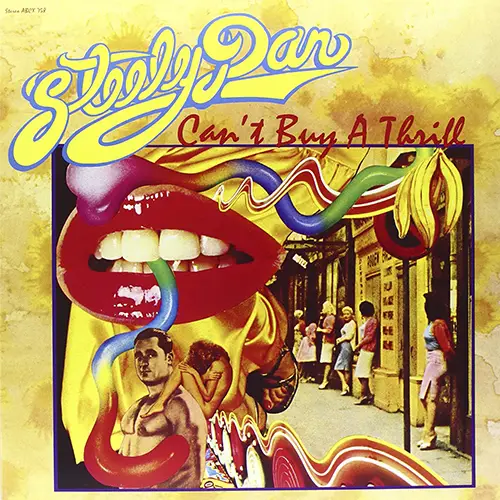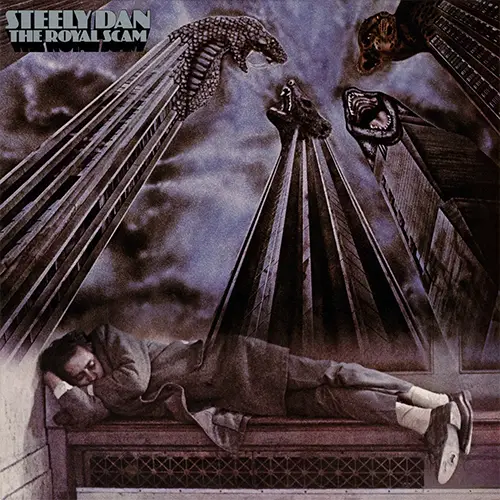When the lyrics to some rock, or to be vague, modern music are concerned, a variation of a line from an old fable could come in quite useful. Mirror, mirror on the wall, who’s most cryptic of them all?
Of course, first name in that respect that would come up to mind would be the recent Nobel prize winner Bob Dylan. Even with all the online search capabilities, it would take you days to just pick up a list of books, academic and other research studies and plain fan comments on the subject. But, who’s next in line?
If you are thinking another singer/songwriter, you can find a few that dabbled in cryptic (Jim Morrison) or were just ‘simply’ full-fledged poets (Leonard Cohen). But certainly next in line for cryptic, often puzzling use of words and meanings are a composing/songwriting duo of Donald Fagen and late Walter Becker, to many, better known as Steely Dan.

When you know she’s no high climber
“Do It Again” from Can’t Buy a Thrill (1972)
Then you find your only friend
In a room with your two-timer
And you’re sure you’re near the end
Then you love a little wild one
And she brings you only sorrow
All the time you know she’s smilin’
You’ll be on your knees tomorrow
You would probably have to start with the name they chose for their one minute real, the other minute imaginary band, its meaning and where they picked it up. And then, when their lyrics are concerned, you would have to sift through a few (thousand) pages of analyses, references, and comments to try to find out what is going on in songs like “Rikki Don’t Lose That Number,” or their actual hits like “Do It Again” or “Aja.”
And while most Steely Dan fans tend to love both their musical variations and lyrics, the discussion and interpretation of the latter has taken on a specific life of its own. Online sites like lyricinterpretations.com have discussions and comments about lyrics of at least thirty Fagen & Becker songs. So what’s in a (Steely Dan) word?
It all started with William S. Burroughs…
Even in the beginning, Steely Dan as a musical/lyrical concept turned into something for the initiated. Whether it was a conscious thing with Fagen & Becker, it makes no difference. But then again, they left that as yet another puzzle for listeners to resolve.
It all starts with the name for the band/project. As students at New York state’s Bard College, the duo were obvious fans of all things good music. The genre didn’t matter. It could have been, rock, soul, or jazz. A lot of jazz. They also turned out to be quite the literary heads too. Actually, literary heads with a penchant for humor, irony and sarcasm. It could have been Jorge Luis Borges or William S. Burroughs.
It was actually the latter’s novel Naked Lunch that gave them the idea for the name of their band later on. Burroughs used the term in this to designate a steam-powered dildo, obviously an ‘interesting’ contraption in itself.
But cryptic, ironic, and sarcastic became terms that would follow Fagen & Becker when they started out in music, even before Steely Dan ‘came to life’. At one point they played as part of the ’60s pop/rockers Jay and the Americans, long enough for the band’s singer, Jay Black, to refer to them as “the Manson and Starkweather of rock ‘n’ roll”.

Up on the hill, they’ve got time to burn
“Aja” from Aja (1977)
There’s no return
Double helix in the sky tonight
Throw out the hardware, let’s do it right
Aja, when all my dime dancin’ is through
I run to you
Their longtime producer Gary Katz brought them to ABC Records in Los Angeles to become staff songwriters but it turned out that their material was both musically and lyrically ‘too complex’ for other artists on the label, so he suggested they form a band of their own.
What came after is a series of some of the most sophisticated rock music thus far. Creem magazine critic Richard Cromelin called them “the best band in America” during his assessment of 1974’s Pretzel Logic. One of the most renowned rock critics around, Greil Marcus, called their “Doctor Wu” couplet – “All night long, we would sing that stupid song/And every word we sang I knew was true” – “two of the finest lines rock and roll has produced about itself.”
Their music itself went through periods when it was lauded and then brought down. The main bone of contention being their latter (first incarnation) ’70s albums Gaucho and Aja; with many critics (and fans) calling them precursors to (dreaded) smooth jazz. Critic Michael Duffy wrote, “‘Aja’ will continue to fuel the argument by rock purists that Steely Dan’s music is soulless, and by its calculated nature antithetical to what rock should be.”
But the again, Steely Dan music went through another re-assessment with Chris Morris writing in Variety that, “to this day, ‘Aja’ is a thing of musical beauty with a hard-edged heart, and a consummate act of creative sleight-of-hand.”
… and then turned into a maze of words
While their music went through a series of critical assessments and re-assessments, Fagen & Becker’s lyrics always remained an element of debate; discussion and search for the ‘real’ meaning was never-ending. As might have been expected, a number of academic papers were written on the subject.
In his article, “Radio Silence – Literature and Rock & Roll,”1 Tim Riley says that, “defying musical logic freed Fagen and Becker to pursue topical themes as rockers retreated into self-involved mythology.”
In a more extensive academic paper,2 Walter Everett writes that, “their obscure, sometimes witty, and rhetorically multileveled lyrics reflect their schoolboy readings of Allen Ginsberg, Kurt Vonnegut, Terry Southern, Joseph Heller, and William Burroughs.”

No I’m never gonna do it without the fez on
“The Fez” from The Royal Scam (1976)
Oh no
No I’m never gonna do it without the fez on
Oh no
That’s what I am
Please understand
I wanna be your holy man
He adds that “following Dylan, the two learned to write song lyrics around the fleeting, disembodied images and emotions related to a topic, rather than in accordance with orthodox linear narratives. Of the ambiguity of their lyrics, Fagen says, “We don’t necessarily try to communicate any specific thing to the listener. It’s more or less us trying to communicate an impression, and the listener has the freedom to interpret as he wants.” Of course, his words are not always to be taken quite at face value; in 1993, he announced, “I’m into my post-ironic phase… which of course would include irony as well. And I’m not talking about the new sincerity, of course, but rather… the pseudo-new sincerity. The notion of irony is often key…”
Riley makes a note that this lyrical style began from the word go, as in “Do It Again” their initial (and possibly best known) single, “gambling became a blanket metaphor for all manner of addictions.”
On the other hand, Everett uses “Brooklyn (Owes the Charmer Under Me),” another composition from Steely Dan’s first album to describe their lyrical style, for which he says, “illustrates the duo’s approach to the musical setting of their central poetic interests:”
A race of angels bound with one another,
“Brooklyn (Owes the Charmer Under Me),” composed c. 1969 from Can’t Buy a Thrill (1972)
A dish of dollars laid out for all to see,
A tower room at Eden Rock, his golf at noon for free
Brooklyn owes the charmer under me,
Brooklyn owes the charmer under me.
According to Everett:
“The intent of this verse seems indecipherable at first-what is the meaning of the refrain (the repeated final line, ambiguously parenthesized for the song’s title), and what connects the four images that lead up to it? The entire notion is abstruse, and remains opaque until one considers the first three lines as a series of treasures, and the ‘charmer’ as a bellyaching Brooklyn apartment tenant living directly beneath the singer. Then, things begin to fall into place: “Brooklyn” is the subject of one long sentence the downstairs tenant, the ‘charmer,’ is the indirect object and the series in the first three lines- a list of what Brooklyn ‘owes’ the tenant-makes up the direct object and thus fulfills the transitive verb in a grammatically correct but oblique way. Of course, one would likely come to this reading only after hearing the composers’ explanation: according to Walter Becker, Donald Fagen once lived in a Brooklyn apartment above an obnoxious neighbor who would regularly sit on his stoop and shout about the indignities he was forced to suffer. The singer’s portrayal is multiply ironic: by using the word ‘charmer,’ Fagen sarcastically presents the obnoxious behavior as an ingratiating manner or as one of casting a successful spell, and he feigns sympathy with the complainer by suggesting what recompense is due in the most hyperbolic exaggerations imaginable. Later verses suggest further desirable amends, including ‘an evening with a movie queen,’ ‘a case of aces done up loose for dealing,’ and ‘a piece of island cooling in the sea.’ And not only are the images themselves of ridiculously high value, they are all described in an ironically velveteen versification”
Of course, academics, rock critics and music researchers are not the only ones debating the meaning of Fagen & Becker’s lyrics. Fans are involved in the debate about all the lyrics, from researching the real-life incidents of the duo, connecting them to any given lyrics, to coming up with interpretations of their own.
For example, one comment discussing their lyrics to “Fez” (Royal Scam, 1976) says: “Always wear a condom. The small reservoir on the tip that becomes conspicuous once the pitcher is actually wearing the glove and approaching the mound – that’s The Fez.”
And it goes on. Practically, lyrics to any Fagen & Becker song is open do debate and discussion. Unfortunately, Becker is not around anymore to shed any light and Fagen probably couldn’t care less. It is now all up to the academics, critics, and fans…
- Volume III, April 2014
- Everett, Walter, “A Royal Scam: The Abstruse and Ironic Bop-Rock Harmony of Steely Dan, Music Theory Spectrum, The Journal of the Society for Music Theory, University of South Carolina, 2001




